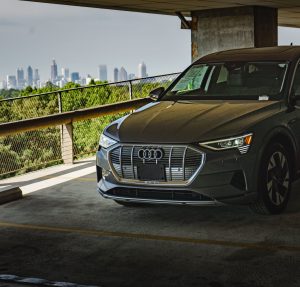Eeny Meeny Miny Mo’ Options For EV’s
 ***This content is sponsored by Audi Atlanta***
***This content is sponsored by Audi Atlanta***
With dozens of all electric models available and more plug-in EV models than automotive journalists can review, electric vehicles are the future of motoring. Technology is developing rapidly designs, are becoming more eye-catching and the world is becoming more environmentally conscious, creating a new era of electric vehicles. Companies like Audi have announced that they will no longer develop traditional combustion engines, highlighting the brand’s commitment to lowering emissions going forward and even announcing plans to offer 20 EVs by the middle of the decade.
So now is the time to get to know EVs a little better. With the internal combustion engine reigning supreme for so long, terms like overhead cam, supercharger, and cylinder are common vocabulary when buying a car. Just as there are a variety of technologies available in conventional vehicles, EVs have different capabilities that can accommodate different drivers’ needs. A major feature of EVs is that drivers can plug them in to charge from an off-board electric power source. This distinguishes them from hybrid electric vehicles, which supplement an internal combustion engine with battery power but cannot be plugged in.
EVs (also known as plug-in electric vehicles) derive all or part of their power from electricity supplied by the electric grid. They include AEVs and PHEVs. AEVs (all-electric vehicles) are powered by one or more electric motors. They receive electricity by plugging into the grid and store it in batteries. They consume no petroleum-based fuel and produce no tailpipe emissions. A good example is the e-tron offered by Audi, the company’s first electric mass production car which debuted for the 2019 model year. The e-tron is an all-electric, midsize luxury crossover with an EPA range of 222 miles that can be charged from zero to 80% in around 30 minutes using 150 kW DC fast-chargers. Rumors are the 2022 models will be able to travel up to 373 miles on a single charge.
PHEVs (plug-in hybrid electric vehicles) use batteries to power an electric motor, plug into the electric grid to charge, and use a petroleum-based or alternative fuel to power the internal combustion engine. Some types of PHEVs are also called extended-range electric vehicles (EREVs). Although plug-in hybrids are considered an intermediate step between non-plug-in hybrids and battery electric cars, they can offer a good balance of performance and fuel efficiency. Take the PHEV variant of the Audi Q5, officially Q5 TFSI e. An electric motor aiding the turbocharged four-cylinder engine delivers 362 horsepower while delivering exceptional fuel economy with 43MPGe in the city, 64MPGe on the highway, and 50MPGe combined. A bonus: it can go 20 miles in electric-only mode.
The writing is on the wall – EVs will one day push gas- or diesel-powered vehicles to the curb. Based on how quickly horses and buggies disappeared in the early 1900s, researchers argue more than 90 percent of all passenger vehicles sold in the U.S. could be electric by 2040. Lucky for you, you now know a little more than you used to.
Learn more about EVs by visiting our EV page.
About Audi Atlanta – Audi Atlanta is a Jim Ellis Family Dealership servicing the Atlanta area and beyond since 1983. The facility delivers about 1,800 new and 1,000 Certified Pre-owned Audis annually with a robust inventory to meet the demand. Audi Atlanta is the nation’s #1 Certified Pre-owned Audi dealership for 12 of the previous 13 years and 2019 and 2020’s #1 Audi Sport dealer in the nation. This Audi Magna Society dealer has been awarded that title for 15 years total and 4 of those prestigious honors were Audi Magna Elite. Learn more about the Audi e-tron by visiting: audiatlanta.com








